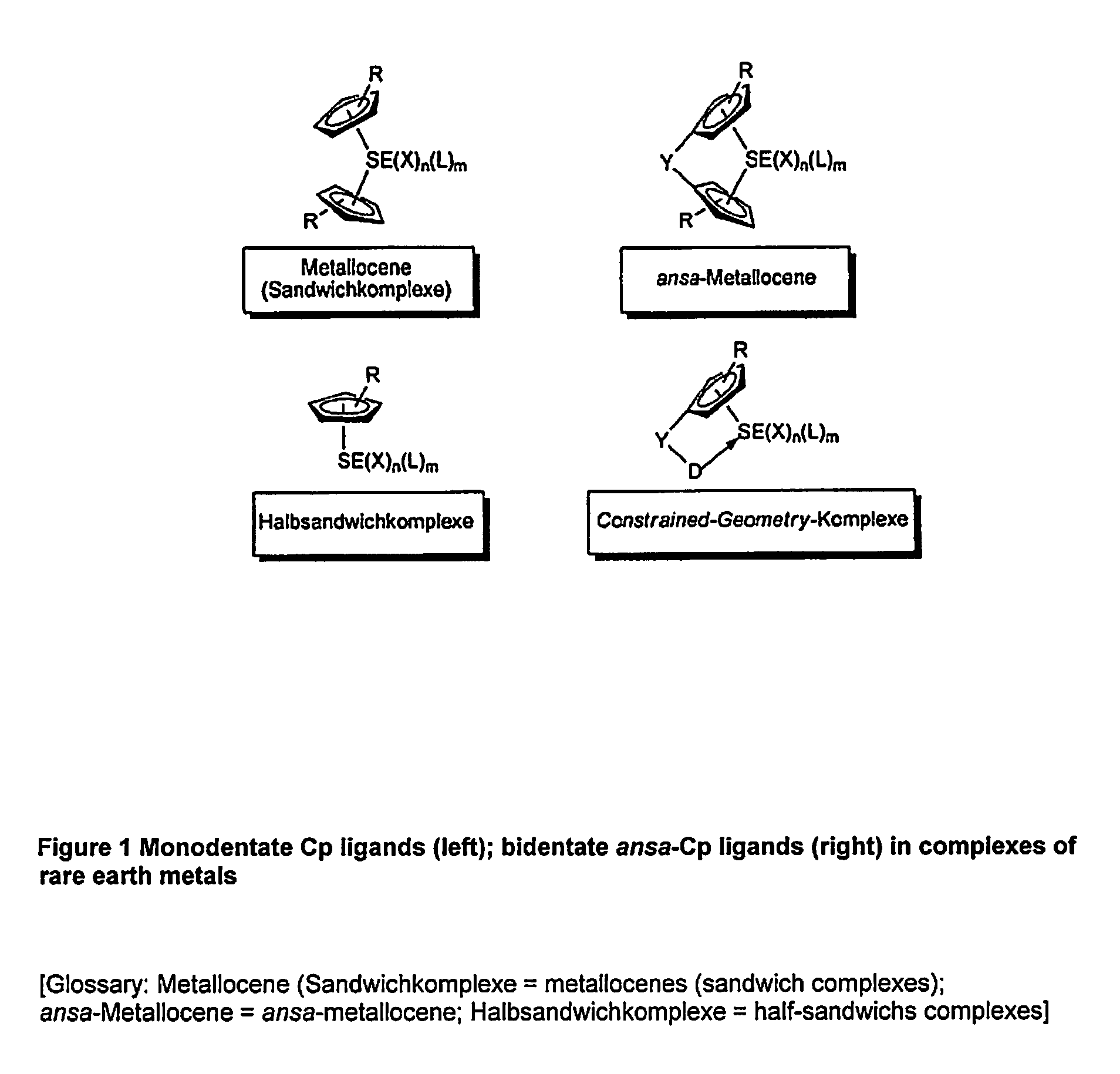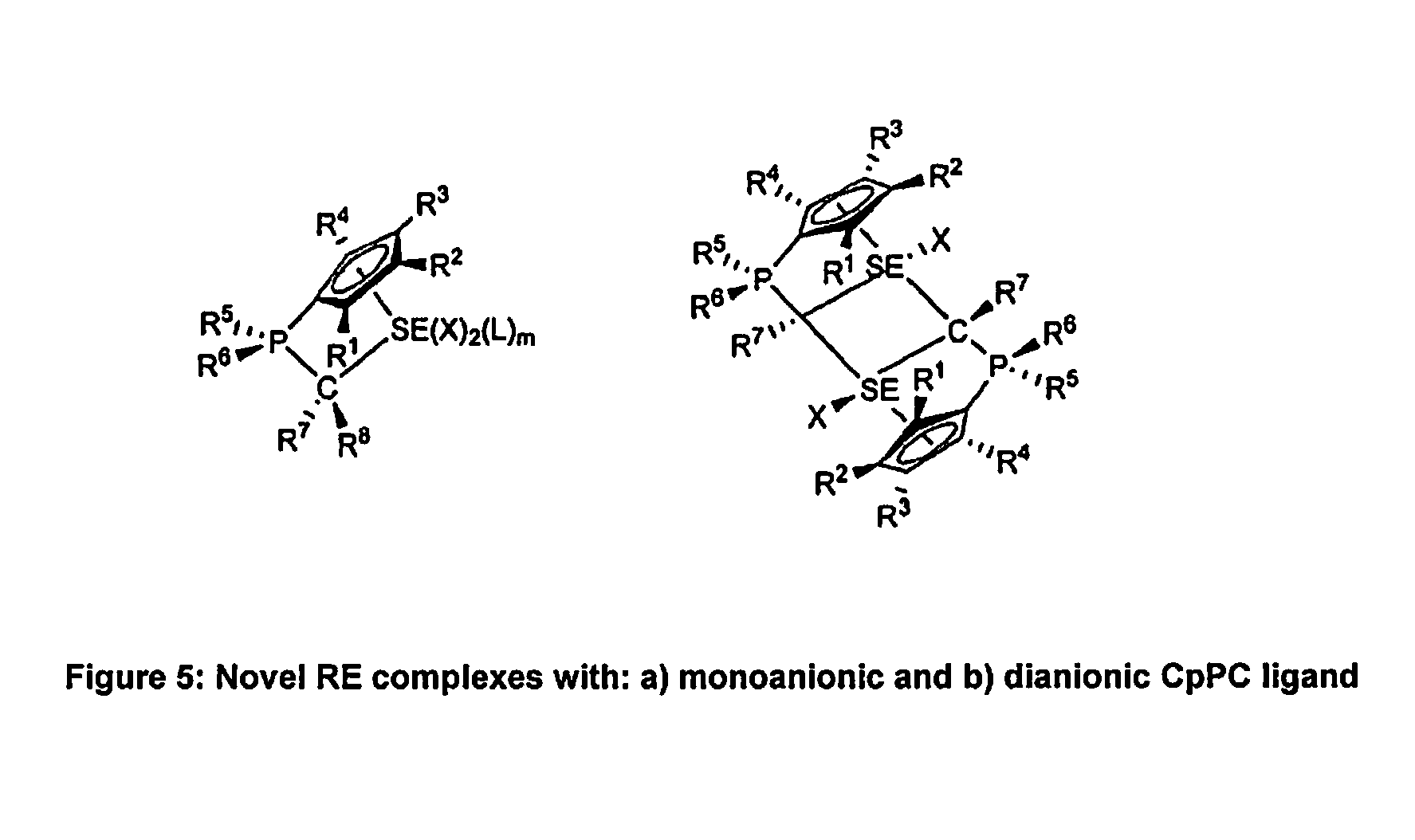Η5:η1-cyclopentadienylidene-phosphorane constrained geometry complexes of rare earth metals
a technology of cyclopentadienylidene and phosphorane, which is applied in the direction of organic compound/hydride/coordination complex catalyst, organic compound/chemical process catalyst, group 5/15 element organic compound, etc., can solve the problem of difficulty in synthesis of such species
- Summary
- Abstract
- Description
- Claims
- Application Information
AI Technical Summary
Benefits of technology
Problems solved by technology
Method used
Image
Examples
example 1
Preparation of [(η5:η1-C5Me4PPh2CH2)YCl2]2
[0087]
[0088]97 mg C5Me4PPh2Me (0.30 mmol, 1.00 eq) and 134 mg [YCl3(THF)2.5] (0.357 mmol, 1.18 eq) are provided in 8 mL toluene. The orange-colored solution with light solid was cooled to 0° C., and 0.6 mL of the PhLi solution (0.5 M in nBu20 / benzene, 0.30 mmol, and 1.00 eq) were dropped in, then the substance then stirred for 1 h at 0° C. During this step, the coloration of the solution disappeared. After the reaction was complete (reaction control by 31P-NMR spectroscopy), the reaction mixture was filtered with CELITE and washed twice with 3-4 mL toluene each time. The obtained filtrate was evaporated in a fine vacuum, and the residue was suspended in pentane.
[0089]The mixture was then centrifuged, the supernatant solution was discarded and the beige-colored solid material dried in a fine vacuum.
[0090]Yield: 129 mg (0.24 mmol, 79%).
[0091]The same result is achieved, when the reaction is done in THP as solvent and with the use of [Ycl3(thp)...
example 2
Preparation [η5:η1-C5Me4Pme2CH2)La(hmds)2]
[0092]
[0093]70 mg C5Me4Pme3 (0.36 mmol, 1.00 eq) and 229 mg [La(hmds)3] (0.37 mmol, 1.03 eq) are first dissolved in 10 mL toluene. The reaction solution is stirred for 2 h at 75° C. A reaction control is done by 31P-NMR spectroscopy. The solvent and H(hmds) are removed at 40° C. in a fine vacuum. The residue is suspended in 3-5 mL hexane and turned into a paste in an ultrasonic bath. The suspension is stored overnight at −30° C. to increase the yield.
[0094]Yield: 227 mg (0.35 mmol, 96%); product: colorless solid material.
[0095]Monocrystals can be obtained from a hexane solution at −30° C.
example 3
Preparation of [(η5:η1-C5Me4PPh2CH2)Sm(CH2SiMe3)2] and [(η5:η1-C5Me4PPh2CH)Sm(CH2SiMe3)]2 on NMR Scale
[0096]
[0097]In a small vessel in the glove box, 11.18 mg C5Me4PPh2Me (0.04 mmol, 1.00 eq) are first dissolved in 0.2 mL C6D6. [Sm(CH2SiMe3)3(thf)3] (0.04 mmol, 1.00 eq) is dissolved in 0.2 mL C6D6 in a separate vessel. The ligand solution is slowly dropped in the precursor solution with a syringe, and the reaction vessel is lightly swung back and forth during this step. The reaction mixture is transferred into an NMR tube, rinsed with 0.2 mL C6D6. The compounds are characterized via NMR spectroscopy.
PUM
| Property | Measurement | Unit |
|---|---|---|
| Temperature | aaaaa | aaaaa |
| Temperature | aaaaa | aaaaa |
| Molar ratio | aaaaa | aaaaa |
Abstract
Description
Claims
Application Information
 Login to View More
Login to View More - R&D
- Intellectual Property
- Life Sciences
- Materials
- Tech Scout
- Unparalleled Data Quality
- Higher Quality Content
- 60% Fewer Hallucinations
Browse by: Latest US Patents, China's latest patents, Technical Efficacy Thesaurus, Application Domain, Technology Topic, Popular Technical Reports.
© 2025 PatSnap. All rights reserved.Legal|Privacy policy|Modern Slavery Act Transparency Statement|Sitemap|About US| Contact US: help@patsnap.com



